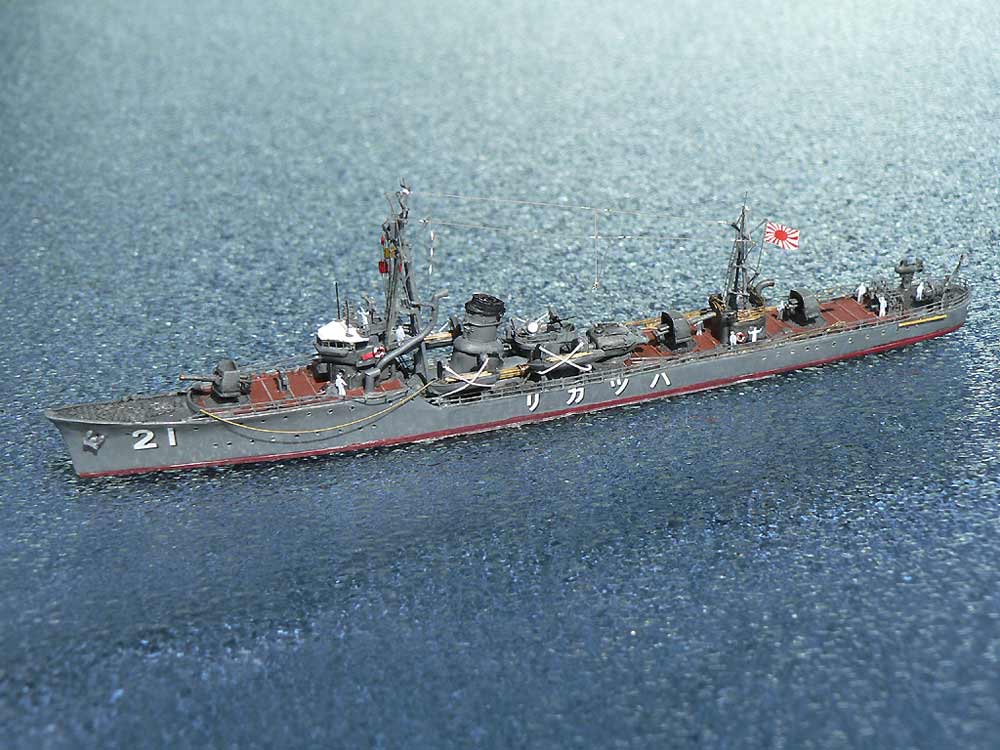by Lars Juel Mosbaek

1/700 IJN Tomozuru and Hatsukari (Pit-Road)

The kit comes with a choice of building 2 ships of the 4 Chidori-Class ships . The TOMOZURU 1935 and HATSUKARI 1945, but firstly I had more interesting in building TOMOZURU as seen in 1934, because of the tragic and thrilling story of the capsize of the ship in bad weather general known as the "Tomozuru incident" this event was the direct cause to the Imperial Japanese Navy's rethinking of how to design and build future warship. Many already existing ships was modified to counter similar fate as TOMOZURU had on the 12th of March 1934. Secondly the kit of HATSUKARI will show the class of boats after the modification (Hull, super structure and armament) in 1935
History of Chidori Class Torpedo boats:
The four ships in the class was: Chidori, Manadzuru, Tomozuru and Hatsukari
The Tomozuru was one of four Japanese Chidori-class torpedo boats, completed on February 24, 1934 and capsized in a storm on March 12, 1934, during training.
The significance of this incident is that it severely challenged Japanese assumptions over the stability of their warships and prompted a major review of the design of all Japanese warships. Existing vessels had their superstructures reduced and ships planned and under construction were redesigned during 1934-35. In particular the Mogami and Tone cruiser classes were significantly altered.
The instability of the Chidoris arose from Japanese efforts to circumvent the various naval treaties. They had designed small vessels of around 600 tons, but with the weaponry usual on a destroyer of twice the displacement. Weight had been saved by lighter construction but gun systems remained complex and heavy. After the launch of the lead ship, its high centre of gravity - even higher than feared - had been noted and efforts made to remedy this. High-speed sea trials showed her to be unstable, however, and further efforts were made to rectify the problem by adding bulges to the hull. Eventually Chidori satisfied the examiners and she was commissioned and the construction of the class, including Tomozuru, proceeded.
In February 1934, Tomozuru joined the 21st Torpedo Flotilla at Sasebo. The training manoevres were made off Sasebo, in rough weather and at 3:25 am, they were abandoned. At 4:12 am, Tomozuru's lights vanished and a search ensued. Eventually the capsized vessel was found at 1 pm and towed back to Sasebo. Sixteen crew members survived, but 100 died, including her captain.
At the time, the Tomozuru was low on consumables such as fuel or water that would have ballasted her and lowered her centre of gravity. On the other hand, munitions were fully loaded, so the situation was significantly worse than on her sea trials.
The ship was later repaired and saw service against China and in World War II. She was part of the naval support force for the invasion of Netherlands New Guinea in April 1942 and was present in the Banda Straits in July 1942.
Tomozuru was sunk on 24 March 1945, at Okinawa by U.S. carrier-based aircraft.
Technical specification
Tomozuru 1934
Hatsukari 1935
Launched 1 Oct. 1933 Maizuru Naval Yard Kosho 19 Dec. 1933 Fujinagata Osaka
Completed 24 Feb. 1934 15 July. 1934
Reconstruction 1934 -
Sunk 24 Mar. 1945 Survived the war broken up 1946
Displacement 535 tons 651 tons
Length 82 m 82 m
Beam 7.4 m 7.4 m
draught 2.5 m 2.5 m
Ship Horse Power 11,000 11,000
Speed 30 Knots 28 Knots
Main Guns 3 - 127mm (1x1 + 1x2) cal 50 DP 3 - 120mm (3x1) cal 45 DP
AA Light guns 1 - 7.7 mm MG or 1 - 40mm MG 1 - 7.7 mm MG
Torpedoes 4 - 21 inch (2x2) with 2 spare carried 2 - 21 inch (1x2)
Type-94 Depth-Charges 48 48
Crew 113 113
Reference:
From the net:
JST Failure Knowledge Database: http://shippai.jst.go.jp/en/Detail?fn=0&id=CB1011021&
Books:
Japanese Naval Warship Photo Album Destroyers and Escorts from Diamond Sha books.
Ships of the World 453 History of Japanese Destroyers
Warships of the Japanese Navy 1869-1945 by Hansgorg Jentschura, Dieter Jung, Peter Michel
Die Japanischen Kriegsschiffe 1869-1945 by Hansgorg Jentschura, Dieter Jung, Peter Michel
Japanese Warships of World War II by A. J. Watts
The building time was approx 3 weeks.
